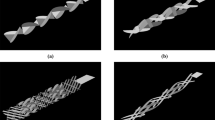Abstract
In the present study, the lamination effect in a micro T-mixer with non-aligned inputs on the mixing index has been investigated numerically in four different cases. The multi-block lattice Boltzmann method has been implemented for the flow field simulation and the second order upwind finite difference scheme has been used to simulate mass transfer. Reynolds numbers includes in the range of 10 ≤ Re ≤ 70. The simulation results show that the lamination effect in the mixer inputs, despite of its simple design, causes the interface of two fluids to increase and also to make the vortex effect stronger in the confluence of two fluid streams that increases the mixing index considerably. Of four lamination cases included for the mixing input, the maximum mixing index is for the vertical and asymmetrical lamination at the Reynolds number of 70 that is equal 0.689 and the minimum mixing index is for the horizontal and asymmetrical lamination at the Reynolds number of 10 that is equal 0.198.










Similar content being viewed by others
Notes
Bhatnagar–Gross–Krook.
Abbreviations
- C:
-
Mass-fraction
- C1 :
-
Water mass-fraction
- C2 :
-
Ethanol mass-fraction
- D:
-
Diffusivity of water and ethanol
- Dh :
-
Hydraulic diameter
- H:
-
Characteristic length
- P:
-
Dimensionless pressure
- Re :
-
Reynolds number
- Sc :
-
Schmit number
- U, V, W:
-
Dimensionless velocity
- \(\vec{V}\) :
-
Velocity vector
- X, Y, Z:
-
Dimensionless directions
- \(\vec{e}_{i}\) :
-
Lattice speed vector in the link of ith
- \(f_{i}\) :
-
Velocity distribution function
- \(\tilde{f}_{i}\) :
-
Post-collision distribution function
- \(f_{i}^{eq}\) :
-
Equilibrium distribution function
- p:
-
Mean static pressure (Pa)
- \(\vec{r}\) :
-
Location vector
- x, y, z:
-
Cartesian directions
- σ :
-
Variance
- \(\tau_{v}\) :
-
Velocity relaxation time
- ν:
-
Kinematic viscosity (m2/s)
- \(\omega_{i}\) :
-
Weighting coefficient
- \(\varGamma\) :
-
Non-dimensional circulation
- \(\zeta_{z}\) :
-
Vorticity in the z direction
References
Ho CM, Tai YC (1998) Micro-electro-mechanical systems (MEMS) and fluid flows. Annu Rev Fluid Mech 30:579–612
Erickson D, Li DQ (2004) Integrated microfluidic devices. Anal Chim Acta 507:11–26
Schönfeld F, Hessel V, Hofmann C (2004) An optimized split-and-recombine micromixer with uniform chaotic mixing. Lab Chip 4:65–69
Torré JP, Fletcher DF, Lasuye T, Xuereb C (2008) An experimental and CFD study of liquid jet injection into a partially baffled mixing vessel: a contribution to process safety by improving the quenching of runaway reactions. Chem Eng Sci 63:924–942
Saatdjian E, Rodrigo AJS, Mota JPB (2012) On chaotic advection in a static mixer. Chem Eng J 187:289–298
Chang CC, Yang YT, Yen TH, Chen CK (2009) Numerical investigation into thermal mixing efficiency in Y-shaped channel using Lattice Boltzmann method and field synergy principle. Int J Therm Sci 48:2092–2099
Kwon S, Lee J (2008) Mixing efficiency of a multilamination micromixer with consecutive recirculation zones. Chem Eng Sci 64:1223–1231
Miranda JM, Oliveira H, Teixeira JA, Vicente AA, Correia JH, Minas G (2010) Numerical study of micro mixing combining alternate flow and obstacles. Int Commun Heat Mass 37:581–586
Afzal A, Kim K (2012) Passive split and recombination micromixer with convergent–divergent walls. Chem Eng J 203:182–192
Conlisk K, O’Connor GO (2012) Analysis of passive microfluidic mixers incorporating 2D and 3D baffle geometries fabricated using an excimer laser. Microfluid Nanofluid 12(6):941–951
Ansari MA, Kim KY, Anwar K, Kim SM (2012) Vortex micro T-mixer with non-aligned inputs. Chem Eng J 181–182:846–850
Galletti C, Roudgar M, Brunazzi E, Mauri R (2012) Effect of inlet conditions on the engulfment pattern in a T-shaped micro-mixer. Chem Eng J 185–186:300–313
Lin Y, Yu X, Wang Z, Tu ST, Wang Z (2011) Design and evaluation of an easily fabricated micromixer with three-dimensional periodic perturbation. Chem Eng J 171:291–300
Hossain S, Husain A, Kim KY (2010) Shape optimization of a micromixer with staggered-herringbone grooves patterned on opposite walls. Chem Eng J 162:730–737
Ansari MA, Kim KY, Anwar K, Kim SM (2010) A novel passive micromixer based on unbalanced splits and collisions of fluid streams. J Micromech Microeng 20:055007
Cortes-Quiroz CA, Azarbadegan A, Zangeneh M (2014) Evaluation of flow characteristics that give higher mixing performance in the 3-D T-mixer versus the typical T-mixer. Sens Actuators B Chem 202:1209–1219
Andreussi T, Galletti C, Mauri R, Simone C, Salvetti MV (2015) Flow regimes in T-shaped micro-mixers. Comput Chem Eng 76:150–159
Yu D, Mei R, Shyy W (2002) A multi-block lattice Boltzmann method for viscous fluid flows. Int J Numer Methods Fluids 39:99–120
Ferziger JH, Peric M (2012) Computational methods for fluid dynamics, 3rd edn. Springer, Berlin, Heidelberg
Azwadi CSN, Tanahashi T (2008) Development of 2-D and 3-D double-population thermal lattice Boltzmann models. Matematika 24(1):53–66
Jung S, Phares DJ, Srinivasa AR (2013) A model for tracking inertial particles in a lattice Boltzmann turbulent flow simulation. Int J Multiph Flow 49:1–7
Krafczyk M, Cerrolaza M, Schulz M, Rank E (1998) Analysis of 3D transient blood flow passing through an artificial aortic valve by lattice-Boltzmann methods. J Biomech 31:453–462
Mei R, Shyy W, Yu D, Luo LS (2000) Lattice Boltzmann method for 3-D flows with curved boundary. J Comput Phys 161(2):680–699
XueLin T, YanWen S, FuJun W, LinWei L (2002) Numerical research on lid-driven cavity flows using a three-dimensional lattice Boltzmann model on non-uniform meshes. Sci China Ser E Technol Sci 56(9):2178–2187
Author information
Authors and Affiliations
Corresponding author
Rights and permissions
About this article
Cite this article
Rabani, R., Talebi, S. & Rabani, M. Numerical analysis of lamination effect in a vortex micro T-mixer with non-aligned inputs. Heat Mass Transfer 52, 611–619 (2016). https://doi.org/10.1007/s00231-015-1584-5
Received:
Accepted:
Published:
Issue Date:
DOI: https://doi.org/10.1007/s00231-015-1584-5




